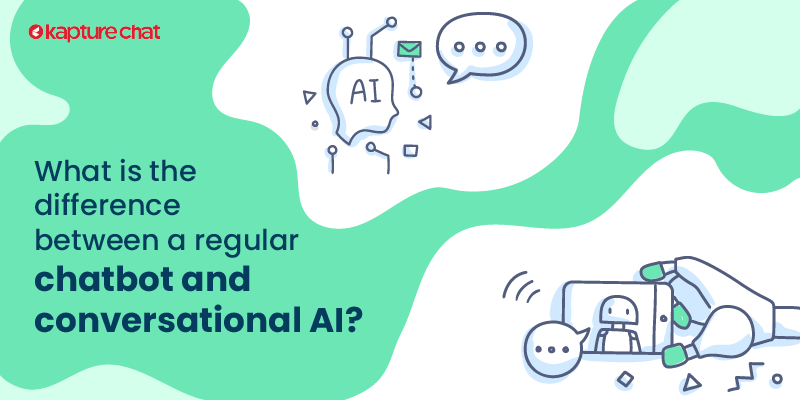Have you ever interacted with a chatbot that keeps responding to you with standard pre-formatted replies, not really catering to your specific question or requirement? It can get quite irritating right? That’s because these chatbots are rule-based and have quite a few limitations.
AI chatbots are designed to solve this problem. Here’s everything you need to know about rule-based chatbots, AI chatbots, and the differences between them.
- What are rules-based chatbots?
- What is conversational AI?
- What is a conversational AI chatbot?
- What are the features and functionalities of conversational AI?
- What is the difference between chatbots and conversational AI?
Businesses of all sizes, across all industries, are increasingly adding chatbots to their workflow (website, mobile apps, social messengers, etc) in a bid to streamline their customer interactions. However, what most enterprises fail to realize is that these chatbots (most often rule-based) are largely limited by their structure. They can only get customers to fill a form or respond with the same pre-formatted replies irrespective of the customer’s unique queries or requirements. Not only is this a waste of time, but it is also counterproductive as it leaves customers dissatisfied with your service.
What are rules-based chatbots?
As the name suggests, rule-based chatbots operate based on pre-set rules and triggers. They are not flexible in nature and can only manage simple, basic interactions. For example, a customer looking for their order status. Customers’ experience with rules-based bots is often not linear.
If the user messages something that is not preempted, the chatbot will not be able to respond correctly. The chatbot will most likely repeat the same question until it receives a response that it can understand. For example, a rule-based chatbot that is designed to help customers place new shoe orders will not be able to respond to a customer asking for matching accessories or prevailing offers. The very nature of rule-based chatbots can be very confining. This is where conversational AI comes into the picture.
What is conversational AI?
Conversational AI is an emerging technology that allows machines to understand, process, and respond to users (or customers) in a human-like language. By leveraging deep learning and natural language processing (NLP), the machine can elevate user experiences into something phenomenal.
AI chatbots can learn from historic data. The bot is capable of identifying and grouping together similar questions and scenarios. Training will be on auto-pilot. As the chatbot learns how a situation has been handled, it teaches itself to act in the same way.
What is a conversational AI chatbot?
Conversational chatbots are AI-powered virtual assistants or digital support agents that facilitate seamless interaction experiences. As opposed to rules-based chatbots, conversational AI chatbots are capable of:
- Accurately recognizing user intent
- Hold a natural conversation
- Understanding misspellings, grammatical errors, etc
- Improving itself every day
- Interacting in multiple languages
- Providing contextual responses and resolutions to customers
With an AI chatbot such as Kapture Chat in place, your customers will no longer feel the frustration they feel when they interact with primitive chatbot solutions. Thanks to these differentiating features, conversational AI chatbots can provide greater user experiences round the clock.
What are the features and functionalities of conversational AI?
- Seamless conversations – Customers expect efficiency when they are interacting with a company. Hence, it is important to engage them in meaningful conversations. Kapture’sAI chatbot can proactively engage with customers, help them with their queries and promote your products/services in an intelligent way. Omnichannel AI chatbots can be deployed across multiple channels (WhatsApp, Instagram, website, etc,) to ensure no customer query goes unanswered.
- Constantly-learning – An AI chatbot uses the abundant customer data and history available from currently available interactions and transactions to learn. Furthermore, the bot uses these learnings to converse, suggest, recommend and engage with prospects and customers. The chatbot software betters itself constantly to power delightful interactions.
- Contextual awareness – Online AI chatbots understand complex sentences of human speech in the same way humans do. By integrating into your current systems and analyzing the right data, the chatbot will know and understand its audience. It can reference previous transactions and interactions to make current interactions smoother, troubleshoot or solve issues in customer service or sales.
- Human-like interactions – Thanks to the natural language processing (NLP) engine, Kapture’s AI chatbot software can understand the intent in customer messages and respond accordingly with relevant responses in human-like language.
What is the difference between chatbots and conversational AI?
| Rule-based chatbot | Kapture’s AI chatbot |
| Rule-based, keyword-driven | Driven by AI and machine learning |
| Operates on manually-coded rules | Understands messages and interprets based on previous learnings and data |
| Is not scalable | Highly scalable |
| Constant requirement to change rules | Easy to train and update as it is data-powered |
| Difficult to train | Reinforcement makes it easy to train |
| Cannot recognize spelling errors | Can understand typos, misspellings |
In addition to these differences, AI chatbots bring many advantages to enterprises. Some of these include:
- 24/7 availability
- Instant, contextual responses
- Multi-lingual
- A wide range of reports and analytics
- Truly omnipresent
- Mirrors human language
- Reduced operational costs
- Reduced unnecessary manpower
The capabilities of an AI chatbot are truly unimaginable. Book a short demo so the experts at Kapture Chat can help you understand how our online chat bot can add value to your business.






